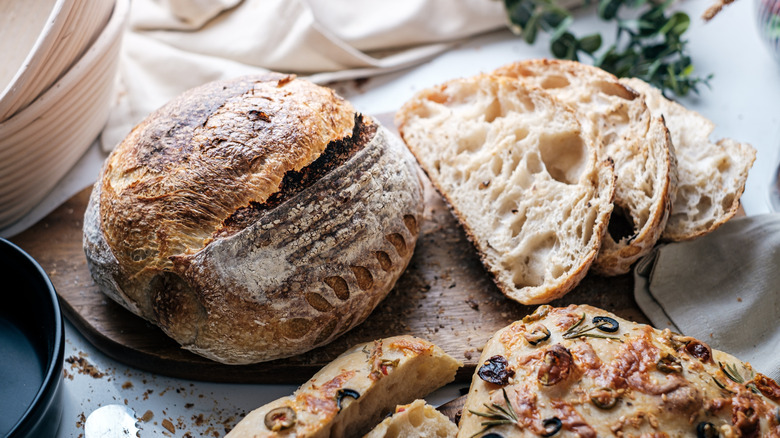The Best Way To Store Homemade Sourdough Uses A Kitchen Stalwart
We may receive a commission on purchases made from links.
Whether it's homemade or store-bought, you may not finish an entire sourdough loaf in a day. Sourdough tends to be more filling than regular bread, and while even some with gluten sensitivities can eat sourdough, it's difficult to overdo it. Storing the remaining loaf properly rewards you with fresh bread the next time you're in the mood for crusty, pillowy goodness. Conversely, a poorly-stored loaf that's improperly can go stale or, worse, get moldy and have to be thrown away. The good news is that because of its higher acidity, sourdough takes longer to go bad than regular bread. You can also use up a dried sourdough loaf to make a hearty Italian ribollita soup which turns stale bread delicious.
While there are ways to salvage a stale loaf, the best option is to not let it go stale for as long as possible. Nathan Myhrvold, founder of Modernist Cuisine and co-author of "Modernist Bread at Home," is an authority on all things sourdough. Along with his team, Myhrvold has tested out several methods for storing bread. While his findings show that after a day or so just about any kind of bread will taste different from the day it was baked, plastic wrapping is one of the best ways to keep your loaf fresh. To give your homemade sourdough bread the best shelf life, it also helps to understand what happens as it ages.
Wrap homemade sourdough bread in plastic
There are several things that happen within a loaf of bread as it ages, Nathan Myhrvold explains. "For one thing, moisture is redistributed. When bread comes out of the oven, the crust is drier than the crumb. After a day or so, moisture begins to migrate to the crust, making it chewy and leathery in the case of crisp-crust breads. Bread dries out as it ages, too, especially if it's not tightly wrapped. It also starts to grow mold."
Myhrvold points out that bread going stale isn't quite the same as bread drying out. The reason a loaf's crumb becomes brittle over time is that the starch in the bread starts reverting to its original state. From being soft and hydrated, it recrystallizes and becomes crumbly. While keeping bread in an airtight box can help slow down staling, moisture may also gather inside and encourage mold growth.
For the best balance of dryness and humidity, Myhrvold encourages folks to wrap sourdough with plastic wrap – no need for specialized bread boxes or dealing with multiple bags. In fact, plastic wrap also helps ripe bananas stay fresh for longer. When it comes to your sourdough, wrap the loaf tightly without any gaps to let air in. While this will help keep your sourdough loaf in good condition for a few days (more if you keep it in the fridge), for long-term storage it's best to wrap bread in plastic and aluminum foil and freeze it.

